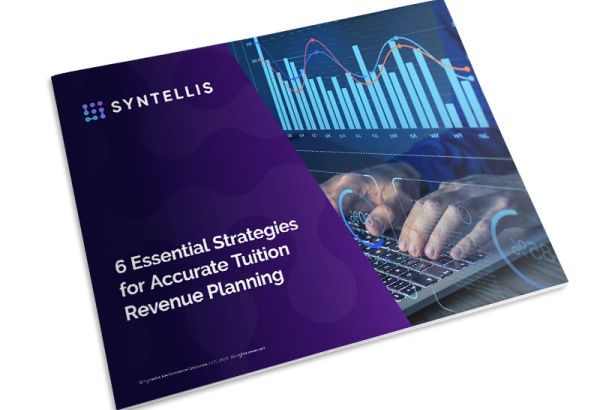Colleges and universities face steep financial challenges now and in the coming years. Higher education leaders ranked the demographic cliff — a sudden drop in enrollment expected to begin in 2025 — as well as declining funding from state and federal sources, as top challenges that will have the greatest financial impact on their institutions over the next 5 to 10 years, according to a Syntellis survey.
As financial challenges escalate, colleges and universities increasingly rely on tuition and fees for revenue. Tuition and fees as a share of revenues at public colleges has doubled since 1980, reaching 41.7% nationwide in 2022, according to the latest State Higher Education Finance Report.i At some institutions, that number was more than 70%. Meanwhile, student enrollment declined 2.5% nationwide from 2021 to 2022, with declines affecting institutions in 41 states, the report found.
With continued enrollment declines on the horizon, institutions must be able to accurately forecast tuition to plan for the future. However, 60% of survey respondents in the Syntellis report believe higher education is behind most industries in adopting modern budgeting and financial planning tools. That’s further demonstrated by the fact that nearly half of respondents said their institutions develop tuition forecasts using spreadsheets, which tend to be cumbersome, static, and prone to error.
To create accurate forecasts to guide long-term success, colleges and universities need more advanced solutions that can handle the planning complexities unique to higher education, including the following benefits.
1. A single source of truth that streamlines collaboration
Tuition revenue planning requires input from many departments across an institution. An advanced planning solution can serve as a single source of truth, aligning data from multiple systems and allowing streamlined collaboration among departments and teams.
Excel, alternatively, makes collaboration difficult. The only ways for multiple individuals to work on an Excel spreadsheet are to email it back and forth or upload and download it from a shared drive. This is time-consuming and tedious and makes it challenging for department heads to keep track of the most current file. It increases the likelihood of human error, such as teams using or submitting out-of-date versions.
2. Flexible scenario-modeling that illustrates the impact of changes
Higher education institutions’ data is rarely static. Leaders expect that the environment will evolve as the year progresses, due to changes like a mid-semester drop in enrollment or a jump in online-only students. An advanced planning solution makes it easy to adjust for constantly changing factors, such as enrollment and melt, by allowing institutions to model different scenarios.
Leaders can’t achieve the same flexibility with Excel spreadsheets, which take an enormous amount of effort on the front end, from inputting and manipulating data to formatting formulas and calculators. Once configured, the spreadsheet has little flexibility to evolve and model different scenarios. This makes it difficult to change course as the year progresses.
3. Integration with other budgets and systems
Tuition planning and forecasting is just one part of the overall budgeting process for colleges and universities, and tuition can significantly impact many different financial areas. With an advanced planning solution and integrated planning process, institutions can connect tuition forecasts with operational budgets and long-range plans. This ensures that higher education leaders can make budgeting decisions based on accurate tuition and enrollment data.
Leaders experience limited value with Excel because it cannot integrate into the institution’s other systems. Even if leaders create a sufficient tuition plan in a spreadsheet, its value ends there as it cannot connect to and influence other budgets and plans.
4. More accurate forecasting
An advanced tuition planning system allows colleges and universities to achieve a predictive budgetary level of planning — using enrollment actuals and demographic trends to anticipate what they can expect over the next several years.
This level of forecasting simply isn’t possible with Excel spreadsheets. Further, unless leaders manually update Excel spreadsheets regularly, they become outdated quickly and offer minimal ability to analyze historical trends and predict future scenarios.
Advanced tuition planning software — such as Syntellis’ AxiomTM Tuition Revenue Planning — helps overcome these obstacles by integrating up-to-date data, fostering institution-wide collaboration, and performing flexible scenario modeling based on the changing factors of the higher education landscape.
For a deeper look into overcoming common tuition planning obstacles, download our e-book, 6 Essential Strategies for Accurate Tuition Revenue Planning.
Learn more about Axiom Tuition Revenue Planning here.
More strategies for improving tuition revenue planning

CFO Outlook for Higher Education

Three Best Practices for Developing Sound Tuition Pricing Strategies


